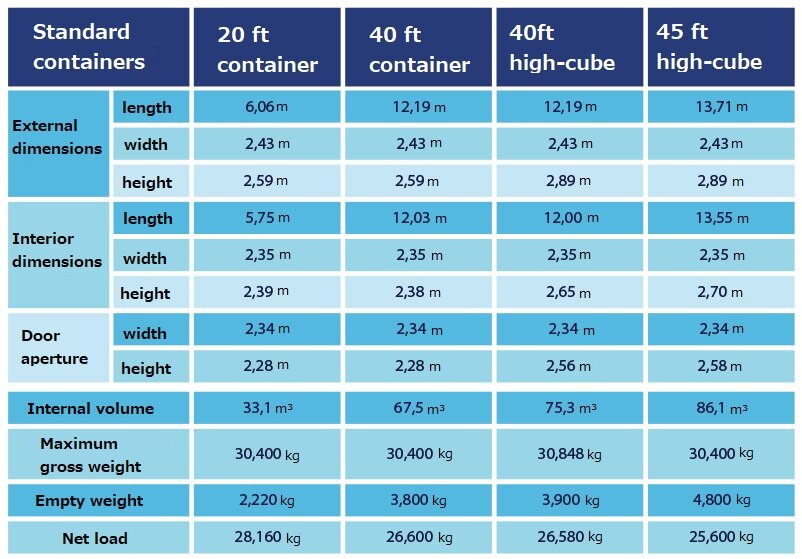For storage or carriage by sea, sea containers are mainly used. Various materials can be used to make them, which allows to create different shapes and sizes. Based on the cargo characteristics, the type and size of sea containers are selected.
The container types
There are different types of containers, but the most popular are «dry» ones (DC – Dry Container).
Containers are divided depending on the cargo type:
- 20FT containers for transportation of heavy and small cargo;
- 40FT containers for transportation of light or heavy large cargo.

20FT container
It is the most sought-after type. Its weight is approximately 2 tonnes, which provides a lift capacity of up to 30 tonnes. It is used when transporting (storing) break-bulk cargo or small cargo.
Main dimensions: length — 6,06 m; width — 2,34 m; height — 2,59 m.
Main types:
- Reefer;
- Ventilated;
- Tank (used for a liquid);
- Open top.
Important features:
- It is made from metal sheets, 33mm thick, that are attached to a steel frame;
- Fully water-proof and dust-proof;
- To keep containers in operating condition, they are treated with the anticorrosive agent;
- Wooden pallers are installed on the floor;
- The floor is additionally fastened for the safe transportation of heavy cargo;
- Double doors have a reliable «locking» system from breaking.
It is important to take into account how many cubic meters in 20FT container there are when determining the cargo size. Internal volume is approximately 33 cubic meters..
To avoid overloading, the weight of 20FT containers is examined.
20FT container size is standard for all manufacturers.
The table above shows all the required dimensions of sea containers to accurately determine the suitability of the container for your cargo transportation.
40FT container
It is used for domestic and international transportation, as well as for consolidated cargo delivery from China. To a greater extent, it applies for heavy, large, consolidated and non-standard size cargo with a weight of no more than 30 tonnes.
For cargo transportation, the following types are used:
- Standard (l – 12,19 m; w – 2,43 m; h – 2,59 m);
- With increased height (l – 12,19 m; w – 2,43 m; h – 2,89 m);
- Wide (l – 13,71 m; w – 2,43 m; h – 2,89 m);
- Reefer;
- Open top.
The size depends on container type and it is selected based on the accurate amount of cargo and its dimensions. There are detailed numerical values in the table.
The number of cubic meters in 40FT container and its weight depend on its type and size.
The main benefits:
- Robust steel frame;
- Sliding doors that can be opened almost fully for comfortable loading and unloading;
- Utilization flexibility;
- Multiple operating features;
- Providing full cargo protection for any mode of transportation;
- The cargo is fully protected from environmental impacts and various mechanical damage during carriage by sea;
- High deterioration resistance.
The most important advantage of 40FT container is the reduction in the cost of cargo transhipment in ports and terminals. It eliminates repacking and the processing speed increases.
Sometimes, the internal volume is measured in Euro pallets. For instance, a 40FT container contains 24 pallets in one tier. Thus, its 20FT counterpart contains half the size of the pallets.
In order to reduce environmental damage during transportation, rational container size is selected for each cargo to reduce the number of containers.
The price of containers depends on manufacturers and year made.
The delivery price is calculated based on the cargo type and distance between A and B. In order to find out the exact price, contact the managers of our multinational logistics company by phone or order the calculation on our website.

